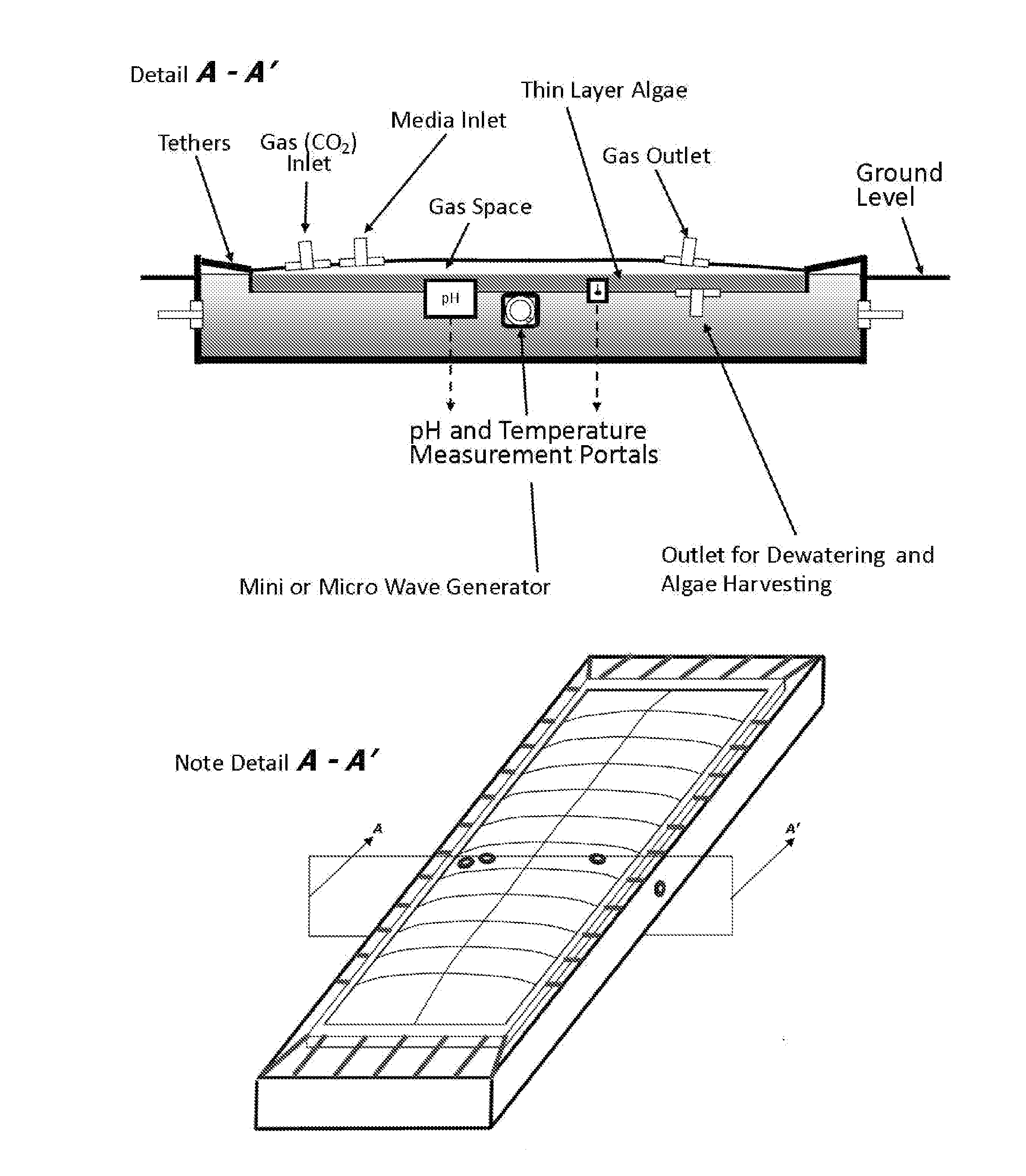Novel photobioreactor for enclosed horizontal cultivation of microalgae
a photobioreactor and closed-system technology, applied in the field of closed-system photobioreactors, can solve the problems of high running costs, large loss of carbon dioxide to the atmosphere, and high structure costs, and achieve the effects of preventing evaporative water loss, preventing the production of toxins, and cost-free operation
- Summary
- Abstract
- Description
- Claims
- Application Information
AI Technical Summary
Benefits of technology
Problems solved by technology
Method used
Image
Examples
example 1
Laboratory Proof of Concept
[0077]As shown in FIG. 11, a Large Plastic Basin Filled 2 / 3 with Water was Fitted with a 4×4 cm wooden board the width of the basin with a rod mounted perpendicular to the center of a long side of the board. The rod was mounted through a plastic pipe just larger than the rod, acting as a bearing to ensure up and down motion. The rod was attached to eccentric cam via a short rod with bearings at either end, on a slow, adjustable motor, such that when the motor is activated, the up and down movement on the board generated waves.
[0078]Grommets are welded ca. 1 cm below the seams on sealed ends food-grade polyethylene sleeve (typically but not exclusively) 0.5 mm thickness) such that it could be loosely or spring-tethered flat on the water with thick rubber bands. Various sealable ports are inserted in the upper sheet of the sleeve: an inlet for medium, an inlet for C02, an outlet with pressure valve that keeps the airspace inflated and releases excess gas, a...
example 2
Larger Scale Pilot Experimental Proof of Concept, Choice of Best Plastics
[0081]The same design with somewhat more sophisticated apparatus is tested on a large scale with parallel modules. Each module is a partially sunken 40 cm ca. 1×2 meter tub (inflatable childrens' pools). The photobioreactors are tethered to the sides of the tubs at water level with flexible cords, to allow waves to mix the algae. Wave generators having adjustable wave amplitude, wave frequency, and period are used, similar to FIG. 3. The wave generators are mounted in one module at short end, in one module along one side of the long side, in one module on both short sides, and in one module on both long ends. This allows generating all wave forms and measuring their damping over distance, with various types of synchrony and asynchrony to determine the most energy efficient ways of transferring carbon dioxide from the airspace to the algae containing medium. Algal photosynthesis is tested at various temperatures...
example 3
Finned Bottom Photobioreactors
[0097]The photobioreactors in this example are identical to those in Example 2, except that flexible plastic fins are attached to the bottom plastic as described in FIGS. 4 and 5. The fins are wiggled by the waves such that they amplify the effect of the waves by wiggling or fluttering the bottom plastic of the photobioreactor. Different photobioreactor fin heights, lengths and distances between fins are checked, and the results costed as fabrication costs vs. energy saving, which will be different for different locations and different for different algal. The distance between the fins is experimentally determined to ascertain the optimal distances such that shear waves are generated that mix the algae layer. These shear waves that form increase the gas-algae interface, facilitating efficient gas exchange between the air space and the algae growth medium, lessening the amount of energy that needs to be expended to dissolve carbon dioxide from the air sp...
PUM
| Property | Measurement | Unit |
|---|---|---|
| thickness | aaaaa | aaaaa |
| thickness | aaaaa | aaaaa |
| depth | aaaaa | aaaaa |
Abstract
Description
Claims
Application Information
 Login to View More
Login to View More - R&D
- Intellectual Property
- Life Sciences
- Materials
- Tech Scout
- Unparalleled Data Quality
- Higher Quality Content
- 60% Fewer Hallucinations
Browse by: Latest US Patents, China's latest patents, Technical Efficacy Thesaurus, Application Domain, Technology Topic, Popular Technical Reports.
© 2025 PatSnap. All rights reserved.Legal|Privacy policy|Modern Slavery Act Transparency Statement|Sitemap|About US| Contact US: help@patsnap.com



